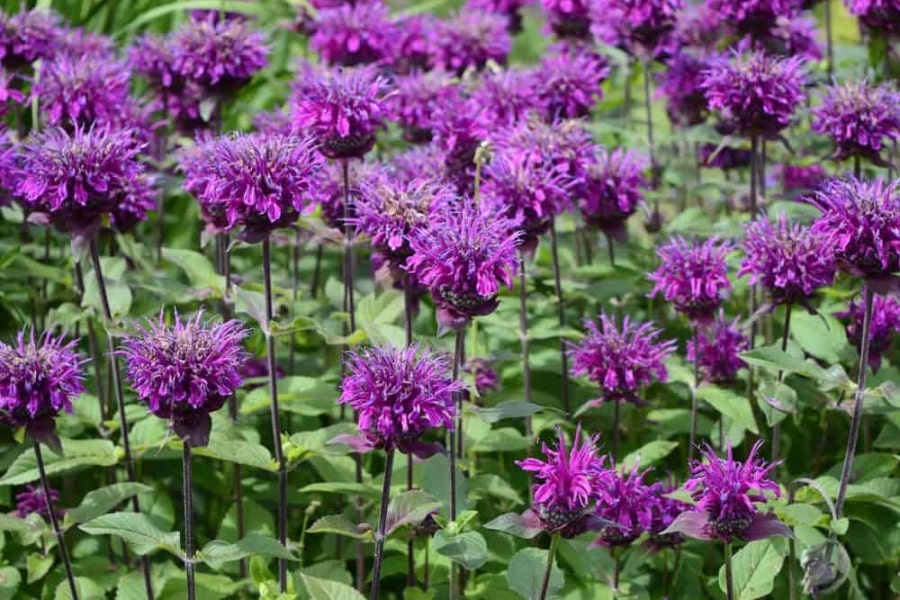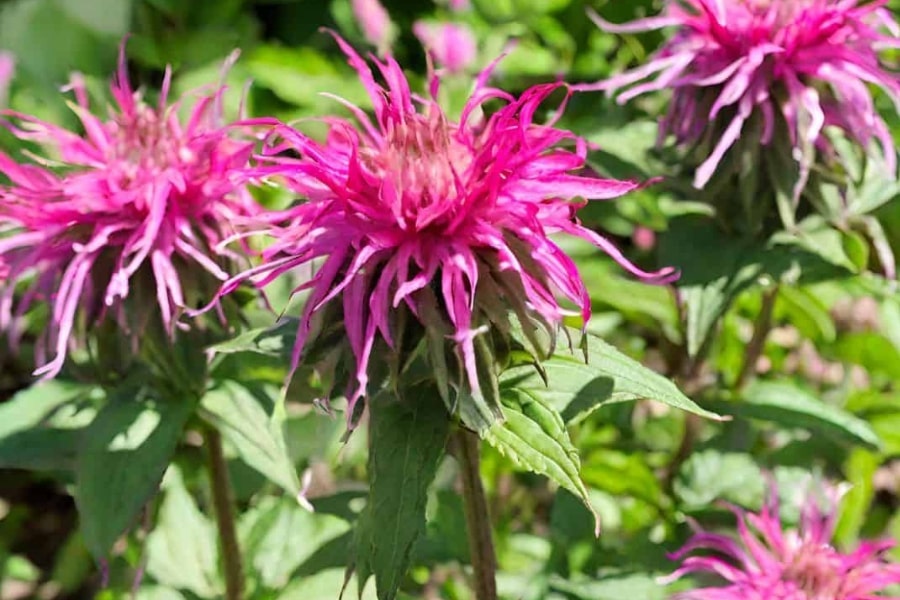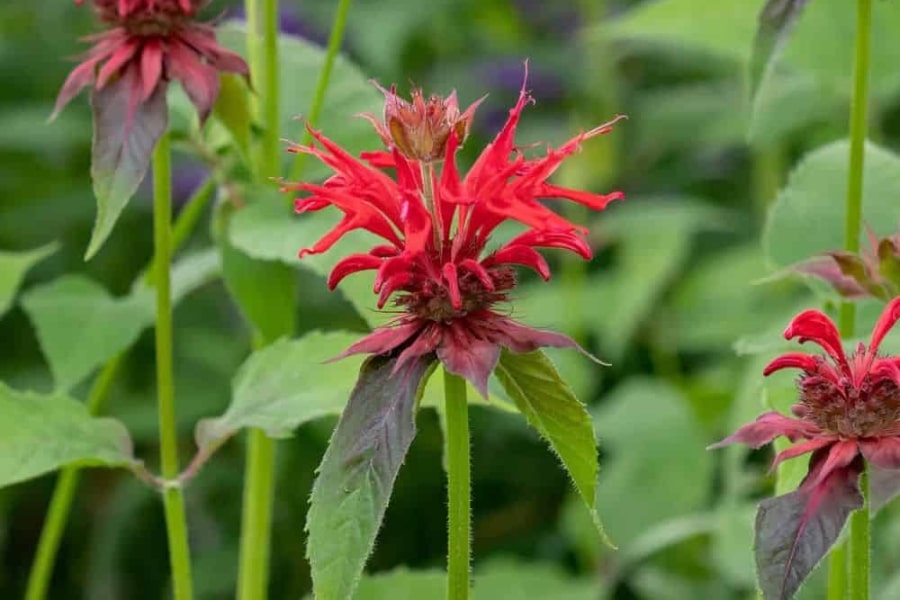Commonly known as Bee Balm, Monarda is a genus of flowering plants in the mint family, Lamiaceae. Monarda is native to North America and includes several species, each exhibiting an upright and clump-forming growth habit that reach heights of 2 to 4 feet tall. These species display various flower colors, from vibrant reds and pinks to purples and lavenders. Its abundant nectar production and showy flowers act as a magnet for various bee species, hence the name “Bee Balm.”

Our Selection of Monarda
We primarily rely on our vendors to provide our Monarda in 4″ containers, with likely varieties including common Bee Balm, Sugar Buzz, Balmy Purple, and more. In addition, we grow the Jacob Cline variety. We may also have some larger Monarda in 1-gal containers, depending on its availability. We try to keep Monarda stocked in multiple colors throughout the year, but availability can be sporadic.
Growing and Caring For Monarda
Monarda prefers to bask in full sun, receiving at least 6 hours of direct sunlight each day. Ample sunlight encourages vigorous growth and abundant flowering and helps reduce the risk of fungal diseases by promoting good air circulation and quicker drying of foliage.
In terms of soil, Monarda thrives in well-draining, moist, and fertile soil. Amending the soil with organic matter, such as compost, enhances its structure and nutrient content. Adequate moisture is essential to support healthy growth and vibrant blooms, especially during the growing season and flowering period. Monarda’s preference for slightly acidic to neutral soil pH (around 6.0 to 7.0) contributes to its overall health and well-being. Ensuring proper pH levels in the soil helps the plant absorb nutrients efficiently and minimizes nutrient deficiencies.
Monarda thrives with a bit of benign neglect, making it a perfect addition to low-maintenance gardens. To encourage vibrant blooms, avoid over-fertilizing the plant, as excessive nutrients often lead to lush foliage at the expense of flowers. Applying fertilizer sparingly—perhaps once in early spring—provides just enough nourishment without overwhelming the plant. Bee balm is happiest when left to flourish naturally!

Monarda’s ability to spread through rhizomes can make it a vigorous grower, necessitating some control measures in smaller garden spaces. However, this can be advantageous in larger gardens or naturalized areas where it can fill out and provide a burst of color and fragrance. Deadheading spent flowers is recommended to prolong blooming and prevent self-seeding. Allowing some flowers to go to seed can be beneficial in providing food for birds.
Monarda is most susceptible to two pests: Aphids and Spider Mites. These common pests can infest Monarda plants, causing damage to foliage and flowers. Regularly inspect plants and use organic pesticides including insecticidal soap for Aphids and neem oil for Mites. But it doesn’t end there … Monarda is also susceptible to powdery mildew. Watch closely when the autumn nights are cool for signs of mildew. Copper fungicide is an organic pesticide that helps prevent powdery mildew. Monarda is worth it … regardless of the pests and disease.
Leaves and Flowers
The leaves of Monarda are elongated and lance-shaped with serrated edges. These leaves are typically medium to dark green, adding depth to the plant’s overall appearance. The leaves release a delightful aroma when gently crushed or brushed against.
Monarda’s flowers are a striking focal point, adorning the plant with vibrant and showy blooms. The flowers are tubular and arranged in dense, spherical clusters at the tops of the stems. The flowers come in shades of pink, red, purple, and white. The unique floral structure includes a prominent central cone surrounded by colorful petals, creating a captivating and intricate appearance.

Uses in the Garden
One of its primary roles is as a pollinator magnet. Monarda’s vibrant and showy flowers act as a beacon primarily for bees but also hummingbirds, butterflies, and other beneficial insects. In addition, some varieties of Monarda can reach heights of up to 4 feet, adding vertical interest to garden beds, borders, and mixed perennial plantings. Its dense clusters of tubular flowers create a striking focal point and inject vibrant color into the landscape. Whether used as a backdrop to other perennials or as a stand-alone feature, Monarda brings a touch of natural elegance and vibrant energy to outdoor spaces.
Monarda or Bee Balm is a major bee attractor. For gardens and bee needy locations, Bee Balm is a must have. Bee Balm flowers all season long … as long as it is maintained. Dead-heading is a necessity when maintaining Bee Balm, in order to keep it blooming and to keep the aesthetic beauty of the plant.

Frequently Asked Questions
Is Monarda a Perennial?
Yes, Monarda is a perennial plant. As perennials, Monarda plants regrow each year from their established root systems, providing long-lasting beauty in gardens and landscapes.
Is Monarda Deer Resistant?
Monarda is considered deer-resistant. Deer typically avoid plants with aromatic foliage or those with a strong fragrance. Monarda fits this description, as its leaves are fragrant and belong to the mint family.
Is Monarda Edible?
Yes, Monarda is edible. The leaves of Monarda plants are edible and have a distinct flavor. They can be used fresh or dried to make herbal teas, imparting a pleasant and aromatic taste. The flavor is often described as a combination of citrus and mint. The flowers of Monarda are also edible and are often used as a garnish in salads or desserts.
Is Monarda Invasive?
Monarda is not generally considered invasive, but certain species and varieties may exhibit varying degrees of spreading. Certain varieties can spread vigorously, forming dense clumps. This spreading habit can be advantageous in areas where ground cover is desired, but it may lead to concerns about its potential invasiveness in more controlled garden settings.
